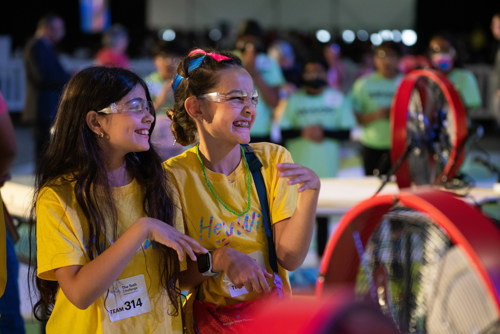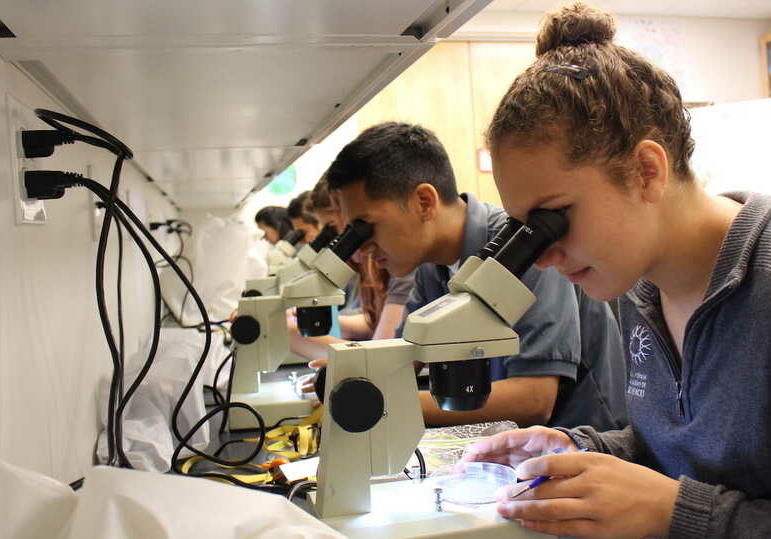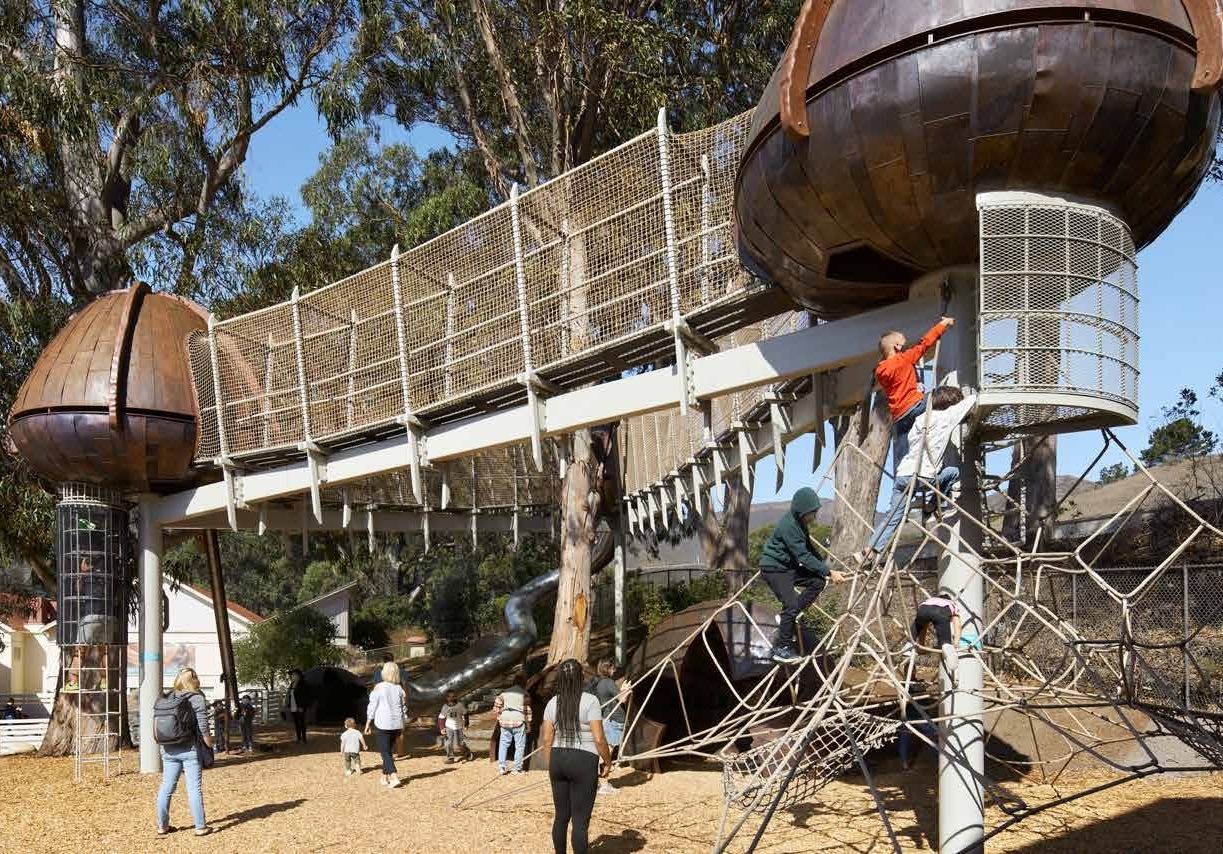The Tech Interactive is technically more than a museum—it is a hands-on science and technology learning center in downtown San Jose, California. It is a hub, a hive, a lab, a launchpad for big dreams and impressive accomplishments. The Tech’s mission is: to inspire the innovator in everyone.

On the surface, The Tech is a family-friendly local attraction, and its surface is large: 132,000 square feet. The Tech is also a world leader in developing training for STEM educators, with the aim of fueling a more diverse pipeline of students pursuing STEM careers. Koret’s recent support helped The Tech scale nationally and internationally, with an emphasis on training teachers of underserved and underrepresented students. The shift to virtual learning during the COVID-19 pandemic accelerated scaling plans, reaching 900 educators and 1.6 million students in 40 countries. The Tech has plans to further expand and deepen its impact over the next three years.
We recently chatted with Katrina Stevens, President and CEO at The Tech. She describes The Tech’s approach as a continuum, from igniting a spark of engagement, to designing activities and projects that develop skills, to giving students the confidence to think of themselves as scientists…to partnering with industry to create career pathways. For students, The Tech offers an extraordinary journey of learning and imagination.
KF: For students visiting The Tech, how do you ignite that magical spark?
We can have a lot of impact when kids come to us on a field trip. Here’s a great example. Last year we had an astronaut, Megan McArthur, do a Zoom session with us live from the space station. She had her choice of anywhere to Zoom with, and she chose us. We have the only IMAX dome west of the Mississippi, and we invited a theater full of fourth graders from around the area to come in and ask her questions. Afterwards, I overheard a young girl tell her teacher, “I think I want to be an astronaut. I didn’t even know I could do that!” One moment can be powerful. And then you build on that by providing other engaging experiences so the students continue to learn—and to think.
KF: That is a great example. And how do you keep the spark alive?
The longer, deeper impact occurs when teachers sustain the spark in their classrooms, so that kids are using engineering and problem-solving principles. The most frequent comment we get when parents and teachers come to the labs on field trips is, “I didn’t know my kids could do that!” We’re intentional about recognizing that, and our people are trained to respond to that—because we want the teachers to think about their students differently. They’re often surprised, and that changes what they do back in their classroom. And we know that for young people to really imagine, to think about themselves differently, they need to have somewhere between eight and 12 exposures to these experiences.
KF: How does The Tech nurture the “future scientist mindset” in a nuts-and-bolts sort of way?
We have developed projects to build skills and confidence. Our signature program is The Tech Challenge, which is the longest running engineering competition in the country—and it attracts over 50% girls participating every year. It is a real showcase, a huge two-day event every April. We describe it as the Silicon Valley Super Bowl for young engineers. We have about 2,500 kids every year, and they feel important, that what they are doing is super-important. Then we have about 10,000 other kids who participate in our summer program. They usually do four challenges over a period of 20 sessions, and that gets kids ready and wanting to participate in The Tech Challenge. We actually want to get to 10,000 students around the country participating in the Challenge. But we are maxed out locally in terms of the physical space.
KF: Can you share a bit of the thinking behind The Tech Challenge’s approach, since it needs to engage students in very diverse circumstances?
The competition is designed specifically to have lower barriers to entry. You don’t need to have or use really fancy, expensive equipment. Technology can amplify access, but it can amplify in both directions and actually deepen gaps. If you’re a young woman in a very rural area of the country, and your school district can’t afford AP teachers or computer science classes, you don’t have access to these things. And then your school gets broadband, and suddenly there’s access, but then your teachers start assigning things online and using digital media…. and then the homework gap starts showing up, with kids who are waiting in parking lots or outside of McDonald’s to do their homework. We have to be conscious at every step. Anytime there’s an innovation, we want to be sure that there’s really access for all.
KF: We know that women, and particularly women of color, are still underrepresented in STEM fields. How do you see this starting to shift?
I think we are in a very different place than we were even 20 years ago, with women going into fields and kind of redesigning them once they’re in there. So, a lot of glass ceilings have been broken in terms of social capital, having access to opportunities and networks. There are a lot of programs for women to get into computer science, for example. But for women of color, the graduation rates are really low. And it’s not about their abilities, it’s about the community—the field—not giving them a sense of belonging. Those communities are not really open and thoughtful about inviting a wider range of people to participate. Actually, I’m spending more time on the newer fields that are still growing, because I think there’s a chance to have more equity in terms of diversity around who goes into fields like augmented reality, virtual reality, artificial intelligence, robotics…and bioengineering, and data science, and cybersecurity. It’s more than, “Hey, if you have a diverse team, you get better solutions.” The more important thing is that diverse folks, who will define problems differently, will actually solve different things.
KF: So, how do you help young women in particular to think about STEM careers?
You need to see it to see yourself in it. This is particularly true for young people of color. When they see a real-life person in one of our videos, they react, “Wow, he’s like me!” and it changes how they think about it. With young women, this effect is actually referred to as The Scully Effect, named after Dana Scully from The X-Files. She was one of the first women portrayed on TV in a science role. A huge number of young women went into science careers after that. They’d say, “Oh, when I saw Dana Scully in that role on TV….” We‘ve seen women in other fictional roles—on CSI, for example—having this effect as well. They have a huge impact on how people think about themselves. We also know that young women actually are more likely to come into tech and STEM through a social cause that they care a lot about. When you come into The Tech, we tell the stories of innovators in different ways. We are very thoughtful around a wide range of folks who are tackling different kinds of problems in the world or in their communities. It is important for boys to see girls in science careers as well, to see that they belong there.
KF: When The Tech sets up mentorships or internships for kids, what do you envision as the longer-term impact?
We’ve found that everybody has a story, and it’s usually about one important teacher or adult somewhere along the way who said, “Hey, you could do this, you’re good at this.” And that one moment can actually have a significant impact in terms of somebody’s trajectory and what they imagine for themselves. What gives me great hope is that it really only takes one adult, one connection, to have access to the network. Actually, statistics show that It’s usually not the first person, but the next person. But once you’re in that network, it actually functions pretty well. If we can find or create the right opportunity or connection for a young person, it can open up quite a bit.
KF: The pandemic seems to have pulled the rug out from under many high school students’ academic plans and aspirations. Do you sense that they, as a group, are bouncing back?
I do. I am so impressed with this generation. We have to make sure that we can keep that energy going and get them the support they need to go forward. Things have changed, even in the last 10 or 15 years. I was a teacher for a long, long time, and when people say that a young person couldn’t do this or that, I have to disagree. Young people can change the world—they don’t have to wait until they’re adults. There are young people who have done some pretty significant things all on their own. We just have to get out of their way. There’s a fearlessness they have, because no one’s told them they can’t do it yet. So, I have a lot of confidence and excitement about the generation of young people that are going to continue to change the world for us.
The Tech Interactive opened in 1998 and has welcomed more than 10 million visitors in its first 25 years. Photo credit: The Tech Interactive





